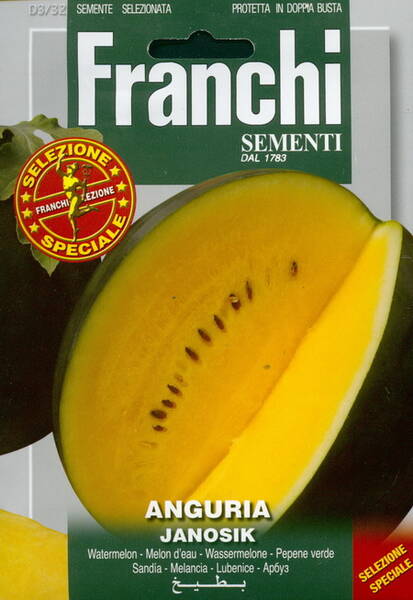Extra class sugar pulp!
An early variety, tolerates minor cold snaps.
Fruits are round-elliptical, weighing 3.5 - 5.5 kg, thin-skinned, dark green with dark narrow stripes and an inconspicuous marble pattern.
The pulp is bright yellow, very juicy, sweet, firm with few seeds. The variety has a stable and high yield, as well as resistance to low temperatures.
Designed for growing in open ground and film greenhouses.
1 gram = 10-20 seeds.

PLANT CARE.
As a rule, within 1 week after planting, no care is required for the plants, except for airing in sunny warm weather. It is necessary to ventilate when the temperature rises above +30°С.
To do this, open the windows of the greenhouse, or roll up the film at the ends of the film shelter.
About a week later, after the soil has dried out, the plants are watered with warm water, combining it with fertilizing with nitrogen fertilizers
(20 g of ammonium nitrate per 10 l of water; 2 l of solution per well). Watered very carefully, trying not to wet the hypocotal knee of plants and leaves.
In the future, the care of plants in a greenhouse and under a film shelter is slightly different. Let's consider them separately.
In the greenhouse.
Approximately 7-10 days after planting, a garter of plants is carried out. The garter system is similar to that used for growing cucumber. Watermelon plants are grown in 1 stem.
With lateral shoots, formed in the axils of the leaves, proceed as follows: shoots, which do not have ovaries, are removed; shoots with fruit set are pinched, leaving 2-3 leaves above the ovary.
When the plant reaches the trellis, it is pinched.
It must be remembered that with the formation of 2, maximum 3 fruits about the size of a chicken egg, all other ovaries are removed, since the plant will not be able to form a larger number of fruits, and they will not have time to ripen.
Melon plants are tied up as follows. After pinching the top of the plant during the seedling period, several lateral shoots are formed in it.
It is necessary to choose the 1-2 strongest of them and lead them as the main one (tying each one to the trellis), and remove the rest. In the future, the formation is the same as that of a watermelon.
In addition to the formation of plants, watering is carried out approximately once a week; during the ripening of fruits, watering is reduced.
In addition to the first feeding with nitrogen fertilizers (about a week after planting), at least 2 more fertilizing with complex fertilizers are carried out with an interval of about 2-3 weeks.
Sometimes one of the fruits begins to grow vigorously, while the rest turn yellow, which indicates insufficient plant nutrition.
When growing in a greenhouse, you need to pay attention to the pollination of the plants.
As a rule, insects fly into the greenhouse through open vents, but if pollination does not occur, then it must be carried out artificially
(transfer pollen from a male flower to the stigma of the pistil of a female flower).
One of the important points when growing watermelon and melon in a greenhouse is the garter of the fruit.
Usually ovaries, which have grown to the size of a large apple, are placed in the middle of a square piece of netting, the edges of which are tied and tied with twine to the trellis.
In this way, each fruit is tied up.
Under the film cover.
The film on the shelters is not removed until about mid-late June (depending on weather conditions). By this time, plants begin to bloom, and insect access is needed for pollination.
After the film is completely removed, the bed is weeded and loosened. Shoots are evenly distributed over the surface of the bed.
As in the greenhouse, after the formation of 1-3 fruits on each plant, all other ovaries are periodically removed and the tops are pinched so that the plant uses all its strength to pour the fruits.
The side shoots that are not bearing fruit are cut out so that the plants are better illuminated.












